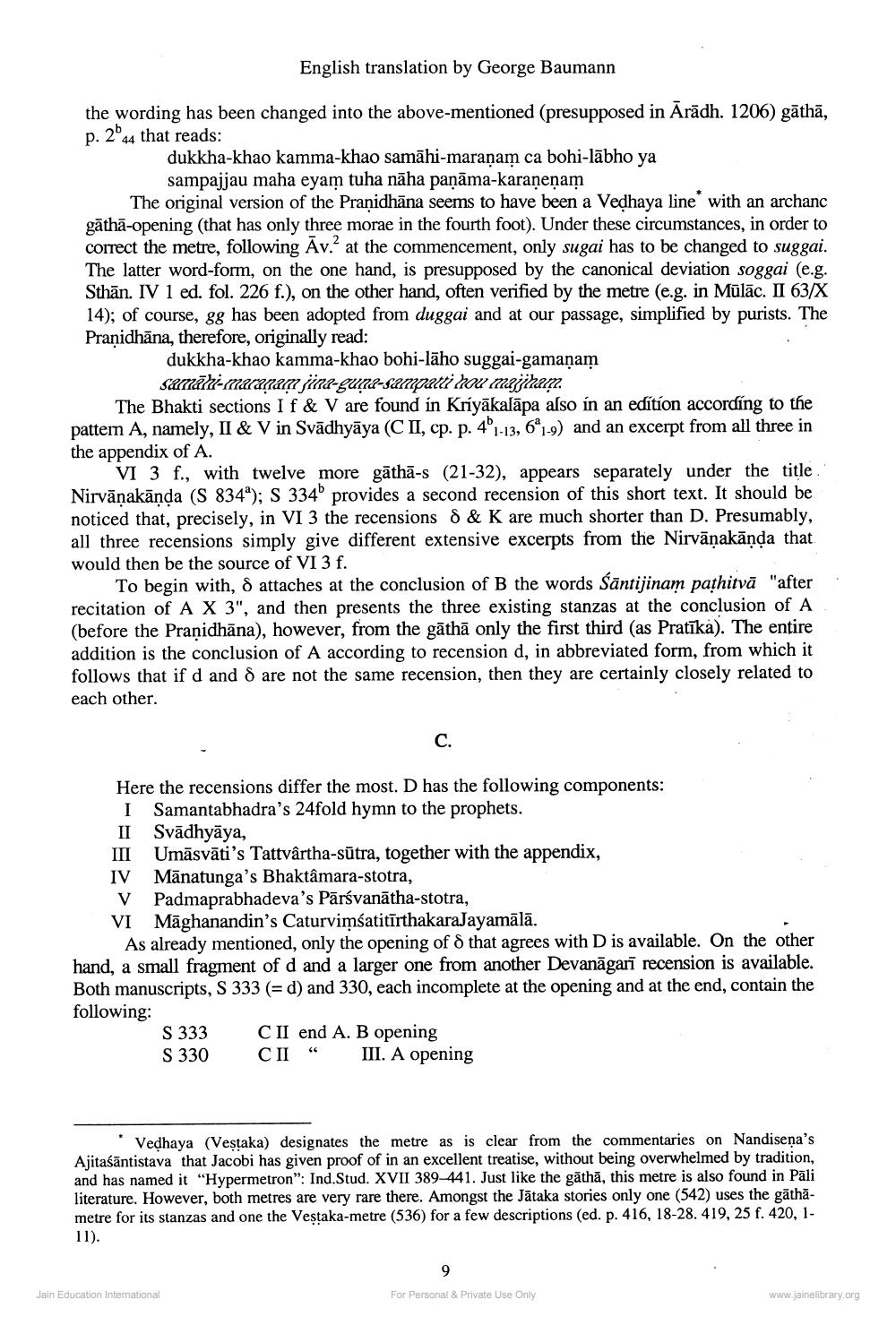________________
English translation by George Baumann
the wording has been changed into the above-mentioned (presupposed in Ārādh. 1206) gāthā, p. 2°44 that reads:
dukkha-khao kamma-khao samāhi-maranam ca bohi-lābho ya
sampajjau maha eyam tuha nāha paņāma-karanenam The original version of the Pranidhāna seems to have been a Vedhaya line with an archanc gāthā-opening (that has only three morae in the fourth foot). Under these circumstances, in order to correct the metre, following Av.? at the commencement, only sugai has to be changed to suggai. The latter word-form, on the one hand, is presupposed by the canonical deviation soggai (e.g. Sthān. IV 1 ed. fol. 226 f.), on the other hand, often verified by the metre (e.g. in Mülāc. II 63/X 14); of course, gg has been adopted from duggai and at our passage, simplified by purists. The Praņidhāna, therefore, originally read:
dukkha-khao kamma-khao bohi-lāho suggai-gamaņam
Samaki-maranam jäna-guna-Sampati kou majan. The Bhakti sections If & V are found in Kriyākalāpa also in an edition according to the pattern A, namely, II & V in Svādhyāya (CII, cp. p. 41-13, 691-9) and an excerpt from all three in the appendix of A.
VI 3 f., with twelve more gāthā-s (21-32), appears separately under the title Nirvāṇakānda (S 8349); S 334 provides a second recension of this short text. It should be noticed that, precisely, in VI 3 the recensions d & K are much shorter than D. Presumably, all three recensions simply give different extensive excerpts from the Nirvāṇakānda that would then be the source of VI 3 f.
To begin with, d attaches at the conclusion of B the words sāntijinam pathitvā "after recitation of A X 3", and then presents the three existing stanzas at the conclusion of A (before the Pranidhāna), however, from the gāthā only the first third (as Pratīka). The entire addition is the conclusion of A according to recension d, in abbreviated form, from which it follows that if d and d are not the same recension, then they are certainly closely related to each other.
Here the recensions differ the most. D has the following components:
I Samantabhadra's 24fold hymn to the prophets. II Svādhyāya, III Umāsvāti's Tattvârtha-sūtra, together with the appendix, IV Mānatunga's Bhaktâmara-stotra,
V Padmaprabhadeva's Pārsvanātha-stotra, VI Māghanandin's CaturvimśatitīrthakaraJayamālā.
As already mentioned, only the opening of 8 that agrees with D is available. On the other hand, a small fragment of d and a larger one from another Devanāgarī recension is available. Both manuscripts, S 333 (=d) and 330, each incomplete at the opening and at the end, contain the following:
S 333 CII end A. B opening S 330 CII“ III. A opening
Vedhaya (Vestaka) designates the metre as is clear from the commentaries on Nandisena's Ajitaśāntistava that Jacobi has given proof of in an excellent treatise, without being overwhelmed by tradition, and has named it "Hypermetron": Ind. Stud. XVII 389-441. Just like the găthā, this metre is also found in Pāli literature. However, both metres are very rare there. Amongst the Jātaka stories only one (542) uses the gāthāmetre for its stanzas and one the Vestaka-metre (536) for a few descriptions (ed. p. 416, 18-28. 419, 25 f. 420, 111).
Jain Education International
For Personal & Private Use Only
www.jainelibrary.org




